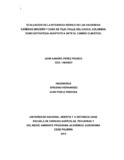Mostrar el registro sencillo del ítem
Evaluación de la eficiencia hídrica en las haciendas cañeras sincerìn y casa de teja (valle del cauca, colombia) como estrategia adaptativa ante el cambio climático.
| dc.contributor.advisor | Hernandez, Efigenio | |
| dc.coverage.spatial | cead_-_palmira | spa |
| dc.creator | Perez Franco, John Sandro | |
| dc.date.accessioned | 2019-06-14T20:10:56Z | |
| dc.date.available | 2019-06-14T20:10:56Z | |
| dc.date.created | 2011-02 | |
| dc.identifier.uri | https://repository.unad.edu.co/handle/10596/26321 | |
| dc.description.abstract | Para mejorar la eficiencia en el riego de las haciendas cañeras Sincerin (105 ha) y Casa de Teja (74 ha), del Ingenio Mayagüez (Valle del Cauca, Colombia), se realizaron evaluaciones en el sitio, Agricultura Especifica por Sitio (AEPS) ante los cambios de clima enmarcados con el tipo de textura presente en cada tipo de suelo estudiado. Y las inversiones en construcción de obras hidráulicas, como canales principales de conducción del agua (revestimiento e instalación de rejillas); se reconstruyó mediante cartografía, el mapa de riego de las haciendas Sincerin y Casa-Teja; se practicó en campo con el equipo de regadores los indicadores de gestión de riego (tipo y humedad del suelo, densidad aparente, capacidad de campo, lámina de agua aprovechada - LAA, lámina de agua rápidamente aprovechable - LARA, Punto de marchitez permanente – PMP); se capacitó a los regadores con la nueva tecnología de riego por ventanas (Caudal por ventana, ventanas por set, Caudal por surco, velocidad de avance, tiempo de salida del agua y longitud del surco); se evaluaron los volúmenes de agua relacionados con la perdida por escorrentía y se realizaron comparaciones con los consumos de agua y rendimientos históricos de las haciendas. Durante los meses de junio a octubre del 2011 se observó que los regadores comenzaron a tener más conciencia sobre el uso eficiente del agua (calibración del set de riego, reducción de pérdidas de agua por rebosamiento a final del surco, aplicación de criterios para asignación de caudal según textura y preparación del terreno y mayor compromiso para la ayuda mutua entre regadores), se pasó de un porcentaje de desperdicio de 35% a 10% al tiempo que se mejoraron los rendimientos en el TCH y las láminas aplicadas se redujeron en 30%. El desafío que continua es sostener estos cambios en el comportamiento de ahorro de agua y seguir explorando herramientas que puedan ser comprendidas y empleadas por los regadores, de tal forma que permita maximizar el recurso y minimizar costos, y le permita al ingenio Mayagüez competir a nivel internacional en productividad y comprometida con el buen uso agrícola del agua. | spa |
| dc.format | spa | |
| dc.format.mimetype | application/pdf | spa |
| dc.language.iso | spa | spa |
| dc.publisher | Universidad Nacional Abierta y a Distancia UNAD | spa |
| dc.title | Evaluación de la eficiencia hídrica en las haciendas cañeras sincerìn y casa de teja (valle del cauca, colombia) como estrategia adaptativa ante el cambio climático. | spa |
| dc.type | Proyecto aplicado | spa |
| dc.description.abstractenglish | To improve the irrigation efficiency of the sugar plantations Sincerin (105 ha) and Casa de Tea (74 ha), the Ingenious Mayaguez (Valle del Cauca, Colombia), evaluations on the site, sitespecific agriculture (AEPS) to changes in climate framed by the type of texture present in each soil type studied. And investments in construction of water, that the irrigators began to have more awareness of water efficiency (calibration set irrigation, reducing water losses by overflow at the end of the furrow application of criteria for allocation texture and flow as site preparation and greater commitment to mutual aid between irrigators), spent a percentage of waste from 35% to 10% while such as driving main channels of water (surface and installation of grids) was reconstructed by mapping, map of irrigation farms Sincerin and House-Tea, was performed in the field with the team indicators sprinkler irrigation management (type and soil moisture, bulk density, field capacity, water depth exploited - LAA, usable water quickly sheet - LARA, wilting point - PMP) were trained with sprinklers the new windows irrigation technology (flow per window, windows set, furrow flow, speed, time out of the water and length of the furrow), we evaluated the volumes of water associated with the loss by runoff and carried comparisons with the consumption of water and past performance of the estates. During the months of June to October 2011 showed improved yields in the TCH and the blades applied decreased by 30%. The continuing challenge is to sustain these changes in the behavior of saving water and continue to explore tools that can be understood and used by irrigators, so to maximize the resources and minimize costs, and enables him to compete with Mayaguez international productivity and committed to good agricultural water use | spa |
| dc.subject.category | Agronomia | spa |
| dc.rights.accesRights | info:eu-repo/semantics/openAccess | spa |
| dc.rights.acceso | Abierto (Texto Completo) | spa |
Ficheros en el ítem
Este ítem aparece en la(s) siguiente(s) colección(ones)
-
Agronomía [574]















